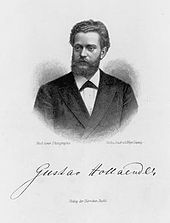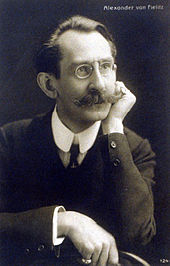Stern Conservatory
The Stern Conservatory was an originally private conservatory in Berlin founded in 1850 , which existed under this name until 1936 and, after being communalized as a municipal conservatory, was its own institution until 1966. Since then, the tradition of the conservatory has been continued as the Julius Stern Institute of the Berlin University of the Arts . Many important musicians emerged from him.
history
It was founded in 1850 as a private company under the name “Städtisches Konservatorium für Musik in Berlin” by Julius Stern , Theodor Kullak and Adolf Bernhard Marx . In 1855 Kullak resigned and founded the New Academy of Music . Since Marx also resigned in 1856, the conservatory was ultimately under Stern's sole direction. Until the establishment of the “Royal Academic University for Performing Music” in 1869, the conservatory was the leading training center for music professions in Berlin and remained an important alternative afterwards. Especially under the ownership and direction of Gustav Hollaender from 1895 to 1915, it experienced a heyday, was attended by more than a thousand pupils per year and managed without any subsidy. In 1899 it moved into rooms in Berlin-Kreuzberg , Bernburger Strasse 21-22 ( 52 ° 30 ′ 18.4 ″ N , 13 ° 22 ′ 38.6 ″ E ), where the Old Philharmonic was also housed. During the imperial era, the retired castle actor and former teacher at the Vienna Conservatory Leo Friedrich worked at this conservatory . He taught at the "Opera School" and was also the director of the "Drama School", which was set up on a trial basis.
In 1935 the institute was renamed “Conservatory of the Reich Capital Berlin” during the National Socialist process of harmonization and “Aryanized” through the dismissal of the Jewish teachers and students . Gustav Hollaender's children Kurt Hollaender , Susanne Landsberg, b. Hollaender and Melanie Herz-Hollaender then founded the “ Jewish private music school Hollaender ” in Sybelstrasse 9 . There also taught Paula Salomon-Lindberg , Anneliese Landau , Oskar Guttmann , etc. The school had temporarily 24 teachers and 150 students. Kurt Hollaender and his wife Herta were deported to the Litzmannstadt ghetto in October 1941 , where they probably perished in the same year. Susanne Hollaender was killed in the Auschwitz concentration camp . Melanie Hollaender probably managed to emigrate in 1939.
After the end of the Second World War , in 1945 the name of the university was changed again to “Städtisches Konservatorium”. The Conservatory has been affiliated with the Berlin University of the Arts (since 2001: Berlin University of the Arts ) since 1966 .
Within the university, its tradition is continued in the “Julius Stern Institute”. This is one of the largest and most renowned institutions for the promotion of young musicians nationwide. At present, around 70 music-loving and particularly talented children and young people between the ages of 9 and 19 receive extensive musical training in addition to attending a general school. The support consists primarily of intensive, age-appropriate individual lessons. Additional courses in music theory and ear training, making music in ensembles such as the 12 cellists of the Julius Stern Institute and the Julius Stern Chamber Orchestra as well as regular performance opportunities inside and outside the university round off the musical training. Numerous students at the Julius Stern Institute are winners of national and international competitions. From 1999 to 2009 the Julius Stern Institute was headed by Doris Wagner-Dix . Anita Rennert has been the head of the Julius Stern Institute since 2010 . She teaches guitar and guitar methodology at the Berlin University of the Arts. In November 1999 the Julius Stern Chamber Orchestra was founded. In addition to the main instrumental lessons, it offers young musicians the opportunity to gain high-level orchestral experience. Since December 2005 the orchestra has been led by Zvi Carmeli , succeeding Andreas Schüller and Christoph Altstaedt .
Directors
- 1850–1883: Julius Stern
- 1883–1888: Robert Radecke
- 1888–1894: Jenny Meyer (1834–1894, singer and sister-in-law of Julius Sterns)
- 1895–1915: Gustav Hollaender
- 1915–1930: Alexander von Fielitz
- 1930–1933: Paul Graener
- 1933–1935: Siegfried Eberhardt
- 1935–1945: Bruno Kittel
- 1946–1949: Heinz Tiessen
- 1950–1960: Hans Joachim Moser
Known teachers
- Hans Ailbout , composer
- Claudio Arrau , pianist
- Herbert Ahlendorf , conductor
- Károly Aggházy , pianist
- Heinrich Barth , pianist
- Karl Gustav Berndal , stage actor
- Georg Bertram , pianist
- Theodor Bohlmann , pianist
- Siegfried Borries Geiger
- Rudolf Maria Breithaupt , pianist and composer
- Hans von Bülow , pianist and conductor
- Gustav Bumcke , composer, theory and harmony, wind chamber music, saxophone
- Erich Bürger , guitarist
- Otto Dienel , organist
- Heinrich Ehrlich , pianist and composer
- Traugott Fedtke , choir director
- Edwin Fischer , pianist
- Eduard Franck , composer and pianist
- Leo Friedrich , actor and dramaturge
- Friedrich Gernsheim , pianist, conductor and composer
- Conrad Hansen , pianist
- August Haupt , organist
- Anton Hekking , cellist
- Victor Hollaender , pianist, conductor and composer
- Engelbert Humperdinck , conductor and composer
- Berthold Kellermann , pianist, conductor and music teacher
- Friedrich Kiel , composer
- Wilhelm Klatte , music theorist
- Martin Krause , pianist
- Arnold Krug , pianist and composer
- Adolf Kullak , pianist
- Theodor Kullak , pianist
- James Kwast , pianist
- Ferdinand Laub , violinist
- Max Loewengard , composer
- Albert Löschhorn , pianist
- Paul Lutzenko , pianist
- Adolf Bernhard Marx , composer
- Jenny Meyer , singer
- Ernst Guido Naumann , pianist, conductor and composer
- Selma Nicklass-Kempner , singer
- Georg von Petersenn , pianist
- Hans Pfitzner , violinist, conductor and composer
- Gustav Pohl, pianist
- Walter Pörschmann , bandoneon, accordion
- Adalbert Quadt , guitarist
- Rudolf Radecke , choir director and composer
- Georg Wilhelm Rauchenecker , composer, music director and violinist
- Fritz Hans Rehbold , pianist
- Julius Reubke , pianist, organist and organist
- Nikolaus Rothmühl , singer
- Philipp Rüfer , pianist and composer
- Émile Sauret , violinist
- Arrigo Serato , violinist
- Margarethe Siems , opera singer
- Leopold Schmidt , music historian
- Arnold Schönberg , composer and music theorist
- Joseph Schwarz , pianist
- Julius Stern , choir director and singer
- Arthur Troester , cellist
- Arthur Willner , pianist and composer
- Konrad Wölki , mandolinist and composer
Known students
- Claudio Arrau , pianist
- Haim Alexander , composer
- Kees van Baaren , composer and music teacher
- Wolfgang Kohly , double bass player, Berliner Philharmoniker
- Hans von Benda , conductor
- Otto Besch , composer
- Edith Boroschek b. Friedländer, soprano
- Manfred Bukofzer , musicologist
- Georg Döring (1861–1945), German opera singer (bass)
- Siegfried Eberhardt , violinist
- Caroline Fischer , pianist
- Edwin Fischer , pianist
- Richard Franck (1858–1938), German composer and pianist
- Aline Friede (1856–1946), German opera singer (alto, mezzo-soprano)
- Isy Geiger
- Hermann Goetz , composer and organist
- Ernst Grenzebach (1871–1936), singing teacher
- Charles Tomlinson Griffes , composer
- Adalbert Gülzow , violinist
- Trude Hesterberg , Soubrette
- Friedrich Hollaender , composer
- Emil Honigberger , choirmaster and organist
- Walter Jenson , trumpeter, orchestra conductor and arranger
- Otto Klemperer , conductor
- Margarete Krämer-Bergau , singer
- Peter Kreuder , composer
- Horst Kudritzki , pianist, composer and orchestra leader
- Hanne-Lore Kuhse , chamber singer
- Franz Landé , musician and conductor
- Ari Leschnikow , singer with the Comedian Harmonists
- Melitta Lewin
- Hannah von Mettal , translator
- Moritz Moszkowski , composer
- Armin Mueller-Stahl , actor, musician, painter
- Emmy Neiendorff
- Alberto Nepomuceno , composer
- Selma Nicklass-Kempner , singer
- Felix Nowowiejski , organist,
- Manuel María Ponce , composer
- Joseph Plaut , reciter
- Margarethe Quidde , pianist and cellist
- Heinrich Reimers (pianist)
- Julius Reubke , pianist, organist and composer
- Karl Ristenpart , conductor
- Eddie Rosner , violinist
- Walter Schartner , composer
- Ruth Schönthal , composer
- Carl Schuricht , conductor and composer
- Meta Seinemeyer , singer
- Willy Sommerfeld , silent film pianist
- Mischa Spoliansky , composer
- Christian Stadelmann , violinist
- Bruno Walter , conductor
- Marek Weber , violinist and orchestra leader
- Ruth Wolffreim , opera singer (soprano)
literature
- Ernst Otto Nodnagel: Commemorative sheets for the inauguration of the new rooms of the Stern Conservatory of Music in Berlin . Berlin 1899.
- Cordula Heymann-Wentzel: The Stern Conservatory of Music in Berlin - a private training institute owned by Berlin Jewish families . In: Beatrix Borchard , Heidy Zimmermann (Ed.): Musical worlds - worlds of life . Cologne 2000, ISBN 978-3-412-20254-5 , pp. 249-263
- Cordula Heymann-Wentzel: The Stern Conservatory of Music in Berlin: Reconstruction of a suppressed history. Dissertation. University of the Arts, Berlin 2010 Download
- Katharina Schmidt-Hirschfelder: Modern music school. The Julius Stern Institute celebrates its 160th birthday . In: Jüdische Allgemeine , November 18, 2010
Web links
- Personal database of the Stern Conservatory in the archive of the Berlin University of the Arts
- Sources for "The Stern Conservatory of Music"
- Julius Stern Institute
- Jewish private music school . In: Memorial plaque directory of the Luisenstädtischer Bildungsverein
- Julius Stern Institute for the promotion of young musicians . District lexicon on berlin.de
Individual evidence
- ^ Klatte, Wilhelm / Misch, Ludwig: The Stern Conservatory of Music in Berlin: 1850-1925. Festschrift for the 75th anniversary , p. 50



